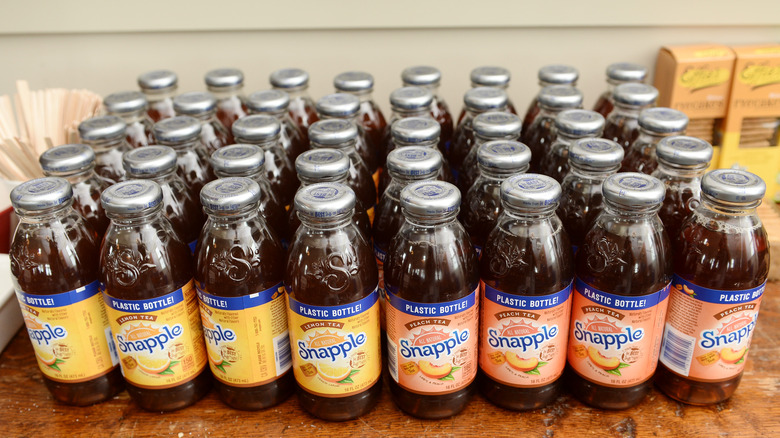The Explosive Origin Story Of Snapple
Snapple is one of those American products whose presence feels so ubiquitous you don't even think about it; much like Gatorade and the perpetually affordable Arizona iced tea, every convenience store in America has them. It was the first broadly successful soft drink to use real juice (although there are now competitors like Izze), and it's left its mark on the American ecosystem. And to think, it all started with some exploding soft drink bottles.
Using the word "explosive" to describe its history isn't metaphorical; Snapple's origin story literally involves exploding soda bottles. Though the drink got its name from a combination of "snappy" and "apple" (a catchy combo that stands as one of the better examples of 20th-century marketing), it could've gone very differently. The company's first attempt at a product was a carbonated apple juice with a combustibility that is typically less than desirable in the field of beverageering.
It turns out fermented apple juice has explosive properties
The origins of Snapple began with three friends: Arnie Greenberg, Leonard Marsh, and Hyman Golden. Working out of the back of Greenberg's parents' pickle store, the three set out to create an apple-flavored soft drink, a niche not represented on the market during the late 1970s. Their goal was to use only natural juice for the flavoring, and they succeeded — eventually. Their first attempt, though, was a bit combustible.
Their first attempt was a carbonated apple juice — basically, what Izze's apple flavor is today. But the way they made and sealed the drink didn't preclude fermentation, and that's an issue. When a liquid ferments, it produces carbon dioxide, which builds up the pressure inside the container. From there, it's a short step to the entire thing quite literally exploding, which is precisely what happened with the early batches of Snapple.
Lots of foods are surprisingly combustible
More foods are explosive than you might think, though. Any sealed beverage can theoretically explode; home brewers often encounter this problem with kombucha or beer. Pop tarts, when left in a toaster with the timing lever held down, will eventually combust, producing flames of up to three feet in length. Flour dust is highly flammable and can create huge explosions if a closed space is filled with airborne particles; it's why flour mills had a history of exploding before the introduction of 20th-century safety standards. Peanut oil is a particularly noteworthy case, as it can be processed into glycerol — a.k.a. one of the critical components in nitroglycerine, the thing that makes dynamite go boom.
Fortunately, the three friends who created Snapple stuck with it after their initial explosive endeavors. They may be best known for their juices and teas, but eventually, they even figured out the carbonation issue, and today, they produce a vast range of products, none of which explode.


